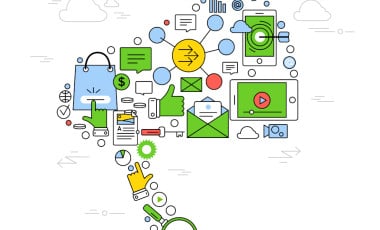Boosting Your Audience Engagement with Content Personalization
As a content marketer or CMO, it is essential to understand what content your target audience finds helpful and informative when looking up your business. Understanding your target audience's needs is crucial to generate revenue and making the sales and growth journey a smooth experience. Content personalization is a systematic way of finding out what content your target audience likes to consume and providing them with relevant and informative content.
This article discusses the following three things:
- Search and Demand: Find out which topics are in demand. This will help in producing content that people are willing to read.
- Content Personalization: Use the data we have to adjust our content so that our customers feel like it was made for them.
- Trends and Open-Source Data: We can gather information outside of our data to get a detailed insight into the current trends.
Search and Demand
Almost 80% of readers will convert to a lead if provided with personalized content.1 If we understand what users are searching for and their demands, we can understand their interests and find what motivates them.
Keywords
If we understand what users are searching for and their demands, we can understand their interests and find what motivates them. Keywords are the foundation of understanding the user's intent, and we must keep an eye on them.
Every question they search on Google has a keyword. Google uses those keywords (words or phrases) to match and deliver the content users seek.
Learning more about the different types of keywords will help us in the long run.
Finding Demand
After getting an idea about keywords, we need to find the keywords in demand.
Google Keyword Planner is an excellent tool for this job. We can use it to identify trending keywords and topics.
This tool will provide us with lots of reliable information, especially if we are researching keywords as a part of our pay-per-click campaign.
All we need is a Google Ads account. This tool has an excellent feature called Search Volume and Forecasts. Here, we enter the keywords or phrases we want to use on our site.
Keyword Planner will generate a forecast report for every keyword showing how many conversions and clicks we can expect within the next 30 days.
After we have planned which keywords to use after using Google Trends or similar sources, the forecast will help us to get even better insight and strengthen our chances of success.
A/B Test and Learn
Another way to learn about our customers is to perform a marketing experiment. And the best way to do so is to use A/B testing2 .
Here, we split our customer base into two groups. Then, show two different types of content to each of them. We can use that data to get a good idea of which content the audience prefers more.
There are many tools in the market to help you run A/B testing. The personalization engine we have created can be used for this purpose. The article Optimizing Website Conversion Rates Through Digital Marketing Experiments will give you an overview of how we use A/B testing to select the copy for our primary call to action.
Content Personalization
The words “for me” have been searched extensively in recent searches.3 This means people are demanding more personalized content.
Content personalization is a strategy where we rely on the data we have gathered from our visitors. Then we use that data to deliver relevant information based on what our target audience likes and is motivated to read. To personalize content, we must understand how things work behind the scenes. This way, we can create loyal customers who consume our content regularly.
We will need to focus on three data types to implement content personalisation.
- Demographic Data: - We look at the user’s age, gender, education level, income, marital status, etc., to display promotional offers accordingly.
- Contextual Data: - Knowing the environment where the user is present will help us find the right content for our customers. Firstly, we check what device and browser they are using. Then, we gather other data like geolocation, weather, media interactions, etc., to fine-tune the personalization.
- Data about behaviour: - Keep track of our customer’s activity on our website. We can check their purchasing behaviour, timing, etc.
Trends and Open-Source Data
We can better understand customers’ interests by looking at open-source data and analyzing them computationally to reveal trends, patterns, and associations. If we can spot this trend and act accordingly, revenue generation will become much more manageable.
Google Trends
Google Trends is a free and handy tool that we can use to find what people search for over a period of time. We can see which trends are increasing and which are losing steam. Initially, it was used for journalism, but then marketers found it useful as well.
One way to understand this tool’s importance is to look at the keywords searched for during the pandemic, like ‘home workouts’, ‘news’, ‘dalgona coffee’, etc. They may look like obvious topics, but CMOs or content marketers who noticed the rise in trend and adjusted their content accordingly saw massive growth in their analytics.
Other Useful Open-Source Data Sources
- Google Dataset: We can use this tool to extract data from sources that are marked properly according to standards.
- U.S. Census Bureau: If we are looking for contextual data like population, and economy, this might be our best tool . We can also embed their visualizations on our website to make it look better and more informative.
- Data.gov US: This site can provide us with information about several topics. They are provided by the different levels of government, giving us accurate and valid data on almost anything we need.
Wrapping Up
Understanding the importance of content personalization, search and demand, and open-source data and trends can greatly enhance a company's revenue generation strategy. By following the lead of successful companies like Google, Spotify, and Netflix, businesses can tap into the power of personalized content and data-driven insights to stay ahead of the competition. Are you interested in the tools that can help you personalize content delivery on a website? Our team is here to help. Contact us today to learn how we can help you deliver tailored experiences to your audience and drive revenue growth.



